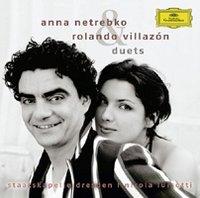Operatic "Dream Team" Releases Love Duets
I am an not even remotely aware of the contemporary opera world. Until handed this disc, I was unaware of either 26 Russian-born soprano Anna Netrebko or 35 year old Mexican tenor Rolando Villazón. The foxy-looking Ms. Netrebko has been called “Audrey Hepburn with a voice,” while Mr. Villazón has not.
So what is this duets album about? Back in the late 1960s when kids began showing an interest in classical music (and the whereabouts of Buffalo Bob and an aging Groucho Marx), major labels picked up the trend and released back catalog classical music excerpt compilations with psychedelic covers and names like Bach’s Head and Tchaikovsky’s Greatest Psychedelic Hits (etc.). You’ve seen low brow “classical music’s greatest melodies” CD compilations and of course have heard of the enormous popularity of “the three tenors.”
This pairing of opera superstars Netrebko and Villazón is non-invasive exploitation of that variety, containing 8 famous operatic duets from “La Boheme,” “Rigoletto,” “Romeo and Juliet” and other well-loved operas.
There’s never a dull or less than bombastic moment on this two LP set recorded, mixed and mastered at the UMG owned Emile Berliner Studios in Hanover, Germany.
Now you know this was an all digital production, which I’m sure was recorded at at least 88.2k/24 bit digital, and probably at 96K or perhaps even higher. So why buy an analog LP of the production? If it was sourced using the high resolution master tape it will sound better than the CD version and even if wasn’t it will probably sound better than the CD version for whatever reasons. Since the LP issue was produced by Clearaudio under the direction of Peter, Robert and Patrick Suchy, you can bet they made sure it was as good-sounding as it could be. After all if it sounded lousy it would be a poor reflection on their turntables and cartridges.
How does it sound? Not at all like clichéd “digital,” nor do most contemporary digital recordings. It’s not at all hard, or bright or thin or anything like that. In fact, it sounds quite the opposite: clear, full-bodied, solid and remarkably transparent and pure. The same can be said of the orchestral recordings, though of course these are studio recordings with whatever reverberation they exhibit being artificially added. It’s been done tastefully here, including a few times where the staging requires one or the other to sound as if he's singing from far away.
Which is not the same as saying listening to this sounds “real,” or that I’m convinced I’m hearing the couple in the flesh as, for some reason, the Annie Ross recording reviewed elsewhere this month made me feel.
I regularly sit in front of an orchestra in the 20th row, and sometimes there are vocalists. This sounds little like that, as pure and attractively supple as it is. It just sounds artificial and somewhat less than vibrant. The difference between this and live, or this and a great analog opera recording from the 1950s or 1960s is like the difference between the giant Rockefeller Center Christmas tree decorated last year with incandescent bulbs and LEDs this year. The “digital” tree has a cool, reserved glow, with a limited color palette. The “analog” (incandescent) tree, well, you could even say it glows.
Still, these voices are gorgeous and I enjoyed listening to all four sides. As “Introduction to Opera 101,” Duets can’t be beat. The German pressing quality is (what else?) superb.
- Log in or register to post comments



